
Restaurant SEO: How To Get Found (And Fully Booked) Online
If your tables are empty but your food is fantastic, search engine optimization (SEO) might be what’s missing.
86% of diners discover new restaurants online before ever stepping out the door, and 62% of them use Google as their go-to source.
That means your online presence and how you rank in search can make or break a potential customer’s decision to book a table, place an order, or scroll right past.
In this guide, we’ll explain what restaurant SEO is all about and unpack how you can boost your search visibility, attract more local customers, and turn Google into a source of foot traffic.
What Is Restaurant SEO?
Restaurant SEO is all about improving your restaurant’s visibility in online search results.
When hungry customers type “best tacos near me” or “Italian restaurant in Brooklyn” into search engines like Google, SEO is what helps your restaurant show up in those search results.
It also helps your search rankings, which means SEO helps your restaurant website appear near the top of search results, rather than being buried on page two, where almost nobody clicks. This is important because the first result on a Google search page receives about 33% of total search traffic.
Why is it necessary to have a restaurant SEO strategy?
The way people find restaurants has changed. Instead of wandering down a street or flipping through the Yellow Pages, they’re pulling out their phones and Googling what and where to eat.
If your restaurant doesn’t show up when people search, you’re missing out on a huge slice of the local dining market, and it’s being dominated by competitors who are optimizing for online visibility.
6 Killer SEO Strategies to Get More Diners
Now that you know what restaurant search engine optimization is, let’s unpack some top restaurant SEO tips so that you can get more customers from Google and other search engines:
1. Local SEO: Get found in your neighborhood
If there’s one part of restaurant SEO you have to get right, it’s local optimization. This is the secret sauce that helps diners in your area find you when they search for things like “pizza near me” or “best sushi downtown”.
Local SEO involves optimizing your website to show up in search results for location-based queries, especially on Google Maps and its Local Pack, which are the first three businesses and an interactive map that appear at the top of search results.
Here is an example of Google’s Local Pack. As you can see, it looks quite different from normal search results:
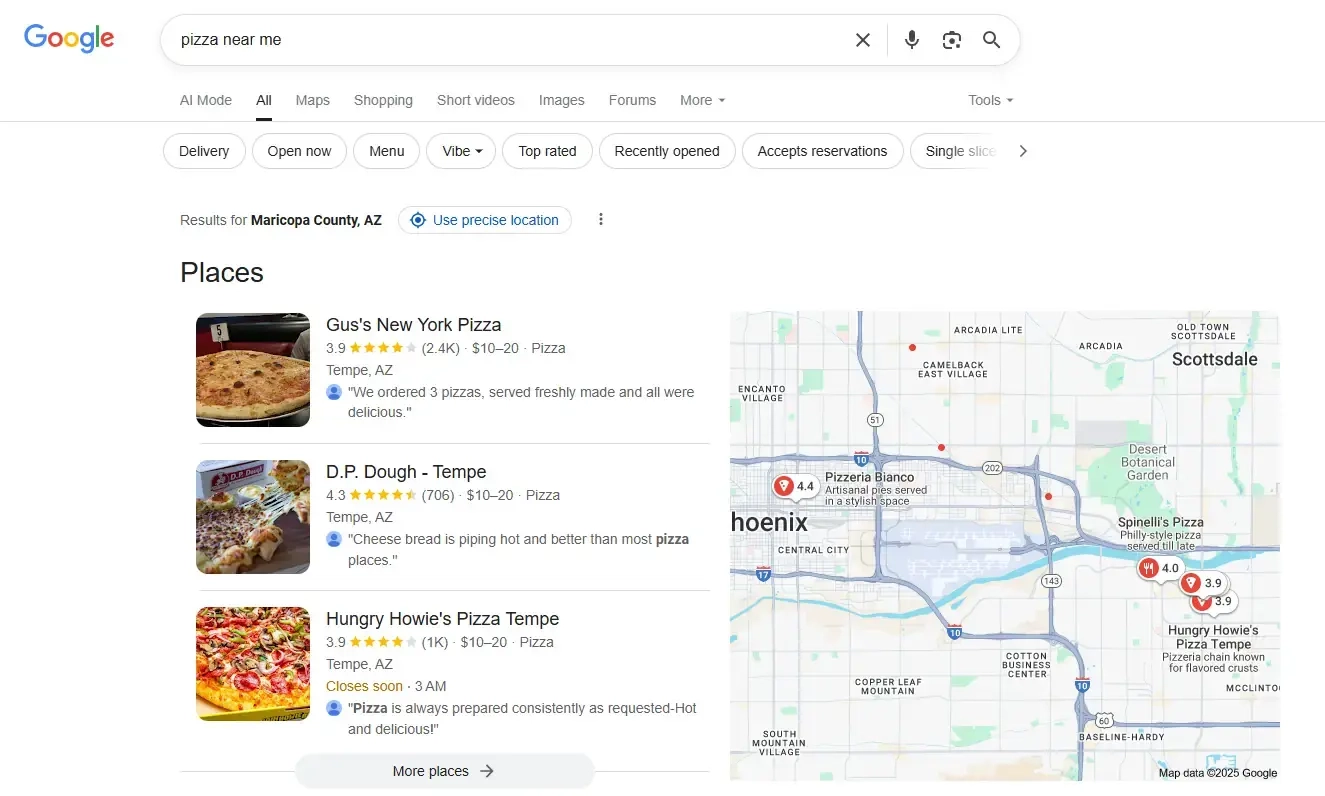
Over 75% of local searches on Google convert, indicating that optimizing for local SEO can bring in highly motivated restaurant guests.
For restaurant owners, this is a game-changer. Why? Because most people aren’t browsing food options two cities over. They’re looking for options close to home, work, or wherever they are
Here are three ways you can improve your local SEO:
Get listed in online directories
You can think of directories as digital phone books. Local directories like Yelp, TripAdvisor, OpenTable, and even niche foodie directories send signals to Google that your business is real and trustworthy.
These listings help people discover your website in different ways, including reviews, photos, menus, and even online ordering links.
Start by claiming or creating your listings, and don’t forget to include:
A compelling business description.
High-quality photos of your dishes and space.
Updated hours and services (like delivery, dine-in, and takeout).
This sushi restaurant has claimed and created a great listing on Yelp with good images of their dishes and complete business information like operating hours and amenities:
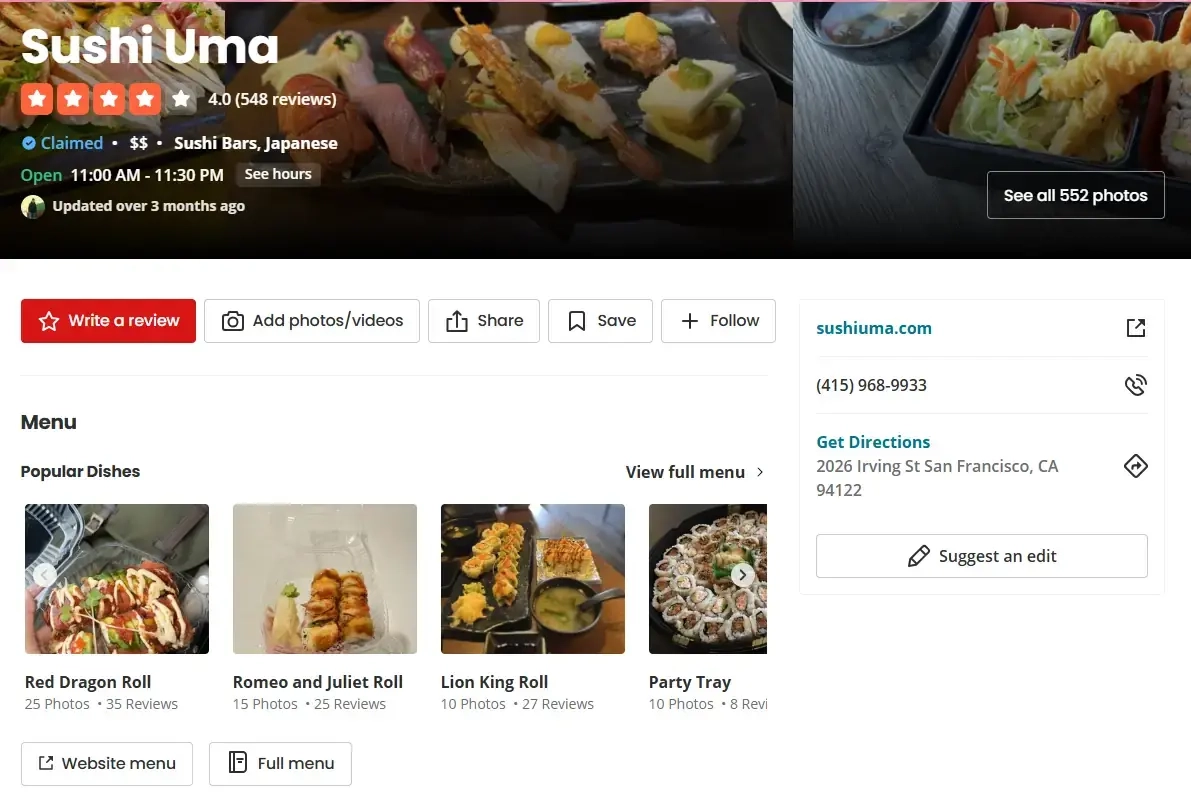
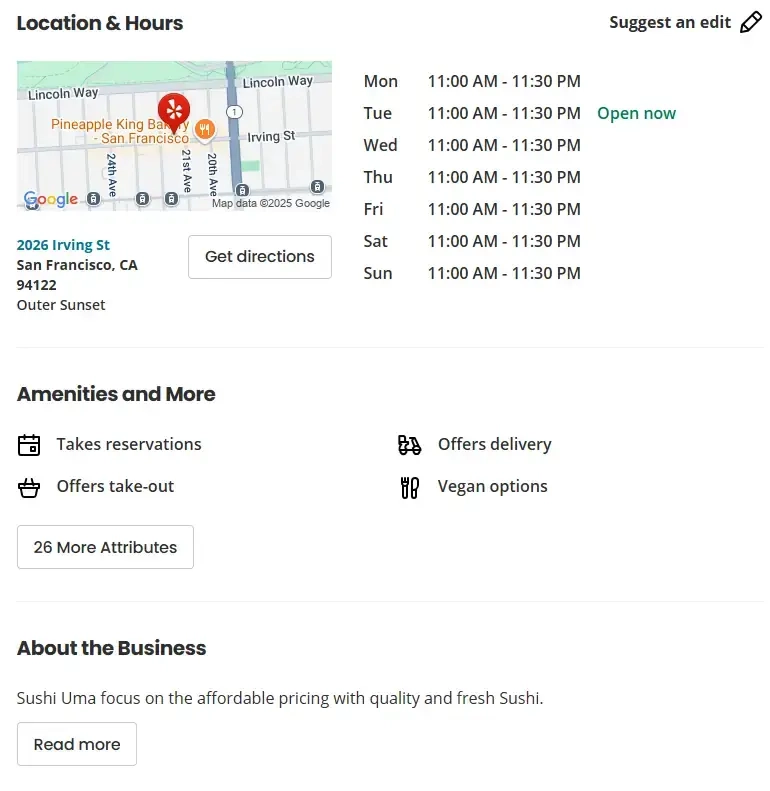
Claim and optimize your Google Business Profile (GBP)
Your Google Business Profile (GBP) is what shows up when someone Googles your restaurant or searches for places to eat on Google Maps.
On average, restaurants get seven times more views on their GBP than on their website, making this an important tactic.
You can optimize your GBP by:
Choosing the right business categories, such as a Mexican restaurant or a seafood restaurant.
Adding a menu or a direct online ordering link.
Responding to reviews, even if they’re negative.
Regularly posting updates like specials, events, or new dishes.
Below is an example of a Google Business Profile for a restaurant. It includes accurate business information, high-resolution photos of their dishes, and they’re actively responding to reviews:
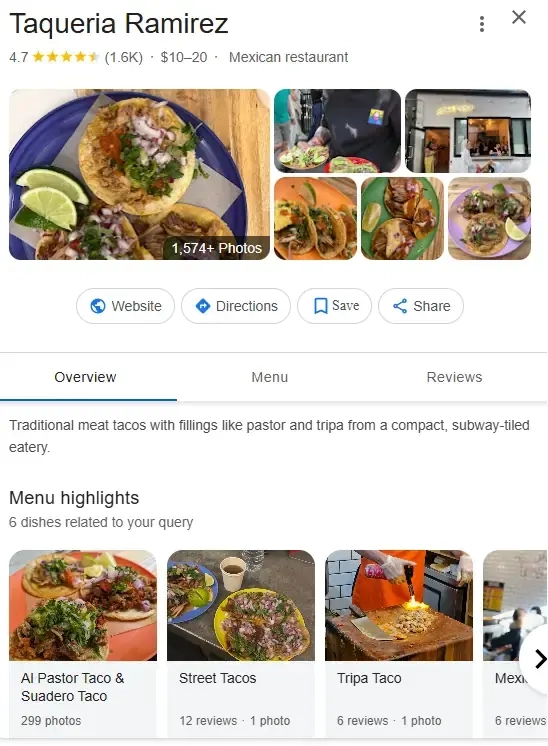
Keep your NAP consistent
NAP stands for Name, Address, and Phone Number, and it needs to be 100% consistent everywhere your restaurant is listed online.
This means that your website, GBP, Yelp, Facebook page, and reservation platforms should all display the same information, including any relevant abbreviations.
Even tiny discrepancies can confuse search engines and hurt your chances of ranking well in local search results.
2. Linkbuilding: Build authority with smart links
Linkbuilding is the process of getting other websites to link to your restaurant’s site. These links, which are called backlinks, act like digital recommendations. They tell Google that your website is trustworthy and worth showing to people in search results.
Link signals contribute about 11% of local pack rankings on Google, which is significant alongside GBP signals and reviews.
The more high-quality backlinks you have, the more likely it is that your restaurant appears higher in Google search results when someone looks for what you offer. It’s like street cred, but for search engines.
Why linkbuilding matters for restaurants
Most restaurant owners focus on things like online reviews and photos (don’t get us wrong, these are super important), but links often get overlooked. Here’s why backlinks are important for your restaurant:
They give you more authority and make your restaurant more competitive in search.
They help Google understand your niche, like if you’re a top sushi spot in Austin.
They drive referral traffic. This is when people click through to your site from other websites like food blogs, directories, or local news sites.
How to earn backlinks for your restaurant
Below is a breakdown of some of the best tactics that work for restaurants:
Get featured on local food blogs: Reach out to local food bloggers and influencers. Offer them a free meal in exchange for an honest review (just be transparent about it). If they write about you and link back to your restaurant’s site, that’s a high-quality, relevant backlink.
Pitch to local news outlets: Hosting a charity event? Launching a new seasonal menu? Opening a second location? That’s newsworthy! Pitch these stories to local journalists or submit a press release. If they cover it, you could score a backlink from a high-authority news site.
Submit to “Best Of” lists and roundups: You’ve seen them: Best Pizza in Chicago, Top Vegan Spots in Portland. Find out who’s curating these lists and suggest your restaurant (especially if you have standout online reviews or a unique concept).
Get listed in niche directories: Beyond Yelp and TripAdvisor, there are dozens of niche directories worth targeting, including vegan restaurant guides, dog-friendly places, and local tourism sites.
Collaborate with local businesses: Partner with nearby businesses like breweries, florists, or local farms and link to each other’s websites. If you’re co-hosting an event, for example, cross-promote it on your websites and social media sites.
Sponsor local events or programs: Many community events, school fundraisers, and nonprofits list sponsors on their websites, often with a backlink. This builds your local reputation and earns SEO points.
Create linkable content: Publish something useful on your own website, like a guide on pairing wine with dishes, a local food guide, or behind-the-scenes videos. Great content like this, also known as linkable assets, is more likely to earn links naturally from bloggers and media outlets.
This authoritative local news outlet has posted a round-up style guide to the best burgers in New York City. As you can see below, each restaurant has received a link to their site, potentially boosting their SEO:

3. Keyword research: Speak your diners’ language
Keyword research is the process of figuring out what your potential customers are typing into Google when they’re looking for somewhere to eat.
These search terms, called keywords, help you understand your audience and optimize your site so it shows up exactly when (and where) people are searching.
Consumers are increasingly looking for immediate dining options, resulting in more “near me” searches on Google.
Why keyword research matters for restaurants
Search engines use keywords to decide what results to show. If your website content matches the terms people are searching for, your chances of appearing at the top of a search results page go way up.
The goal? Use the same words your customers use, not what you think sounds fancy. For example, people may search for “cheap eats Chicago” more than “affordable culinary destinations in the Windy City”.
The types of keywords that boost SEO for restaurants
Below, we unpack the most valuable and relevant keywords you should focus on if you’re a restaurant owner:
Local keywords: These include terms with geographic intent, which are essential for local search visibility. Examples could be “Italian restaurant Boston” or “brunch near me”.
Service-based keywords: These keywords describe what your restaurant offers, whether it’s online ordering, dine-in, or delivery. Some examples include “pizza delivery in Denver”, “family-friendly restaurants with outdoor seating”, or “late-night food near me”.
Discovery keywords: These are the “best of” and “top-rated” searches, which are perfect for capturing diners in decision mode. They could be keywords like “best seafood in Miami” or “top sushi places in Seattle”.
Branded keywords: These include your restaurant’s name and variations of it. People may already be looking for you specifically, so you need to make sure you’re showing up. Examples include “El Gordo Taqueria menu” or “reviews for Mama’s Southern Kitchen”.
Niche or speciality keywords: If you serve a unique audience or style of food, lean into it. These keywords may have lower search volume, but they often bring in more traffic. Some examples are “gluten-free bakery NYC”, “halal breakfast Chicago”, and “kosher sushi Los Angeles”.
An example of keyword research for restaurants
There are some great keyword research tools you can use, including Ahrefs, Moz, and SEMrush. Let’s look at an example of how you can use Ahrefs’ Keywords Explorer to find the right keywords to target.
Here’s what you need to know about Ahrefs before we begin:
Search volume (SV) refers to the average number of times a keyword is searched in a month.
Keyword difficulty (KD) is how difficult it will be to rank on page one of search results for a keyword.
You could aim to target the keyword “Italian restaurant near me”. This is a good keyword because it’s location-specific. But it could be hard to rank for:
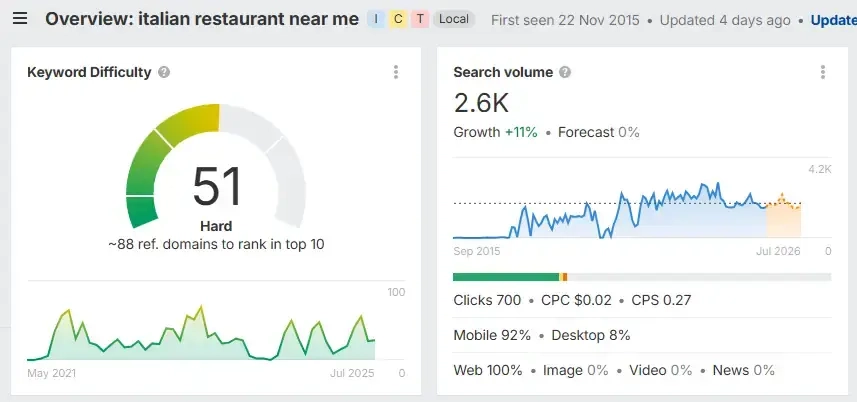
Perhaps you could find a discovery keyword that’s still local, but could be easier to rank for, like “best Italian food near me”. As you can see, it could be a lot easier to rank for and still has good search volume:
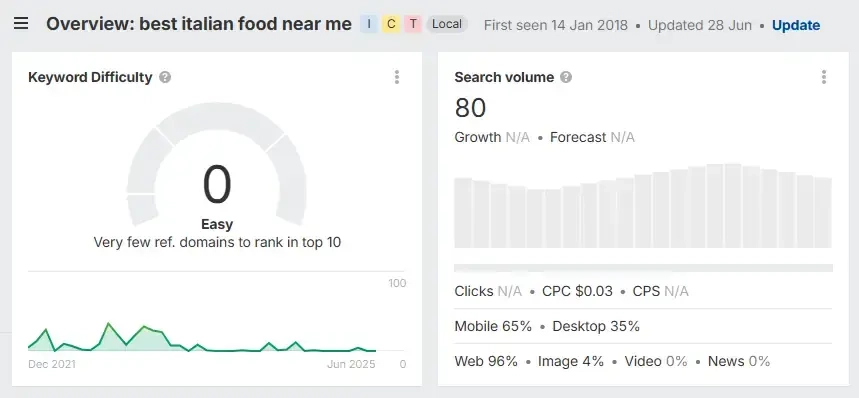
4. On-page SEO: Make your website easy to understand
So your restaurant is showing up in directories, your GBP is looking sharp, and you’ve got some great backlinks. Next comes on-page SEO.
On-page SEO involves optimizing the content and elements on your website so search engines and humans understand what your restaurant is about.
It’s the stuff you have full control over, from the words on your homepage to the way images are described.
Done, right, on-page SEO can boost your search engine rankings, make your site easier to navigate, and help your restaurant business appear online when it matters most.
Let’s look at three important on-page SEO tasks you need to nail down:
Ditch your PDF menu
While uploading a PDF of your menu to your site is quick and easy, it doesn’t help your search engine rankings. Search engines can’t easily read PDFs, and since it's one of the most important pieces of content on your site, hiding it in a PDF isn’t a good idea.
Why you should have a live, HTML menu instead:
Google can discover and index the items on your menu, which can help your rankings.
It loads faster and looks better on mobile devices (where most people are searching).
It’s easier to update, especially if your menu changes seasonally.
It’s accessible to screen readers and voice assistants.
This New York sushi restaurant has all its menus displayed on its website rather than as a downloadable PDF:
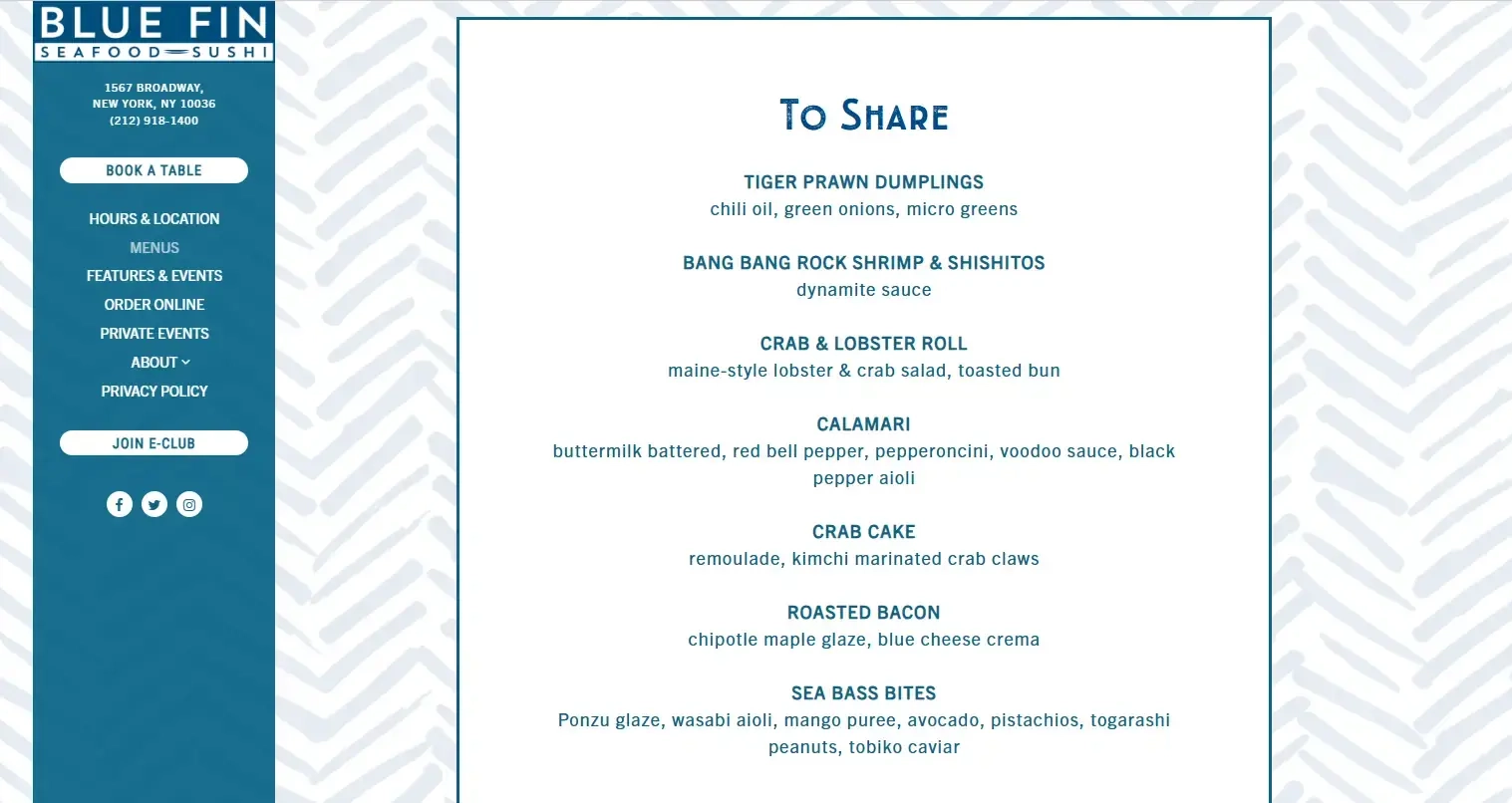
Title tags and meta descriptions
Title tags are the clickable headlines that appear in search engine results, and meta descriptions are the little blurb below.
These tell Google and potential customers what your page is about and whether it’s worth clicking on.
Keep your title tags under 60 characters to avoid them getting cut off in search results, and include your main keyword.
Write clear, compelling meta descriptions that are under 160 characters and highlight what makes your place unique.
The below title tag and meta description are keyword-rich and compelling, potentially getting the restaurant more clicks:

Image SEO
Beautiful photos of your dishes and restaurant are great. But you need to optimize them if you want them to make an impact on your SEO.
Image SEO helps search engines understand what your images are about because Google can’t interpret images the way humans do. It relies on your file names and alt text to make sense of them.
Give your images filenames that describe what’s actually in the photos. For example, instead of “IMG_8924.jpg”, you could try “chicken-parmesan-downtown-boston.jpg”.
Alt text is used by screen readers and also by search engines to understand your images. Bad alt text would be something like “image of food”. A better option would be “Grilled chicken parmesan served with garlic bread at Boston’s Downtown Bistro”.
5. Technical SEO: Keep things running smoothly behind the scenes
While your homepage, photos, and menu might be what diners see, the behind-the-scenes setup also helps your site perform well in search results and delivers a smooth experience.
Let’s unpack three important technical SEO tasks you’ll want to get right (you may want to hire a professional to tackle these for you):
Site speed
No one wants to wait around for a website to load, especially not someone deciding where to eat. If your site takes more than three seconds to load, 53% of visitors will leave.
A slow site can also seriously hurt your search engine rankings and conversion rates because Google prioritizes site speed as a ranking factor.
Here are some tips to boost your site speed:
Compress your images without losing their quality.
Use a caching plugin.
Avoid bloated templates or too many fancy animations.
Minimize unnecessary third-party scripts.
Mobile-friendliness
Over 60% of restaurant searches originate from mobile devices, often while someone’s already out and about. If your site isn’t mobile-friendly, you’re not just losing out on rankings, you’re losing customers.
Google uses mobile-first indexing, meaning it primarily looks at the mobile version of your site to figure out if you’re going to rank. So, if your desktop site is beautiful but your mobile website isn’t great, that’s a problem.
A mobile-friendly site should:
Load fast and look great on all screen sizes.
Use large, easy-to-tap buttons for reservations and your online ordering system.
Display your hours, address, and contact information prominently.
Keep menus readable so customers don't need to pinch or zoom to read them.
Schema markup
Schema markup is a bit of code you can add to your site to tell search engines exactly what your business is: a restaurant with a specific menu, opening hours, location, and reviews.
Schema can help you appear in rich results, which are the listings in Google that show things like star ratings, hours, and reservation links.
Here’s an example of a restaurant that may be using schema markup as they’re getting displayed as a rich result:
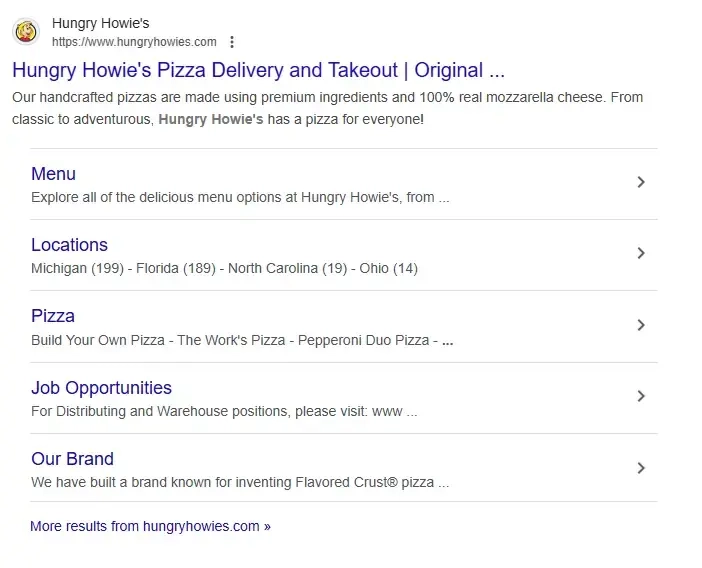
6. Content strategy: Feed Google (and customers) fresh content
If your last update on your website was from your grand opening three years ago, Google’s probably giving your site a miss because it prefers fresh content. That’s where a good content strategy is important. It keeps your site active, relevant, and more likely to show up in search results.
Why content matters for restaurant SEO
Search engines love fresh, useful content. When you regularly update your site, Google sees it as a signal that your business is worth showing to people.
Consistency and longevity matter: top-ranking pages average 2.6 years in age, emphasizing the need for ongoing content creation and updates to build authority and trust.
Quality content also:
Gives you more opportunities to target keywords.
Attracts valuable backlinks.
Keeps potential customers engaged and informed.
Helps you stand out in local search results.
What kind of content should restaurants focus on?
Your content needs to be relevant, helpful, and aligned with what your customers care about. Here are some high-impact content ideas to try:
Blog posts: Snappy blog posts can help you rank for specific keywords and seasonal searches. Your topics could be something like “5 Must-Try Dishes at [Your Restaurant Name]” or “Where to Eat in [Your City] Before a Show”. Blog posts also make for great social media content when repurposed.
Events and seasonal specials: Hosting live music? Running a Valentine’s Day menu? Post it! Create a dedicated page or blog post with all the details, and include your local keywords.
Customer stories and testimonials: Feature real feedback from happy customers. Create a testimonials page or spotlight reviews in blog posts. Not only is this great for social proof, but review-based content can help your business appear in branded and discovery searches.
FAQs and how-to content: Answer common questions on your website, such as “Do you have vegan options?” or “Is there parking available?”. Creating an FAQ page can also help you rank for voice search queries and improve the user experience all at once.
On its blog, this restaurant explores all kinds of topics, including tips, guides, and news related to the business as part of its content strategy:
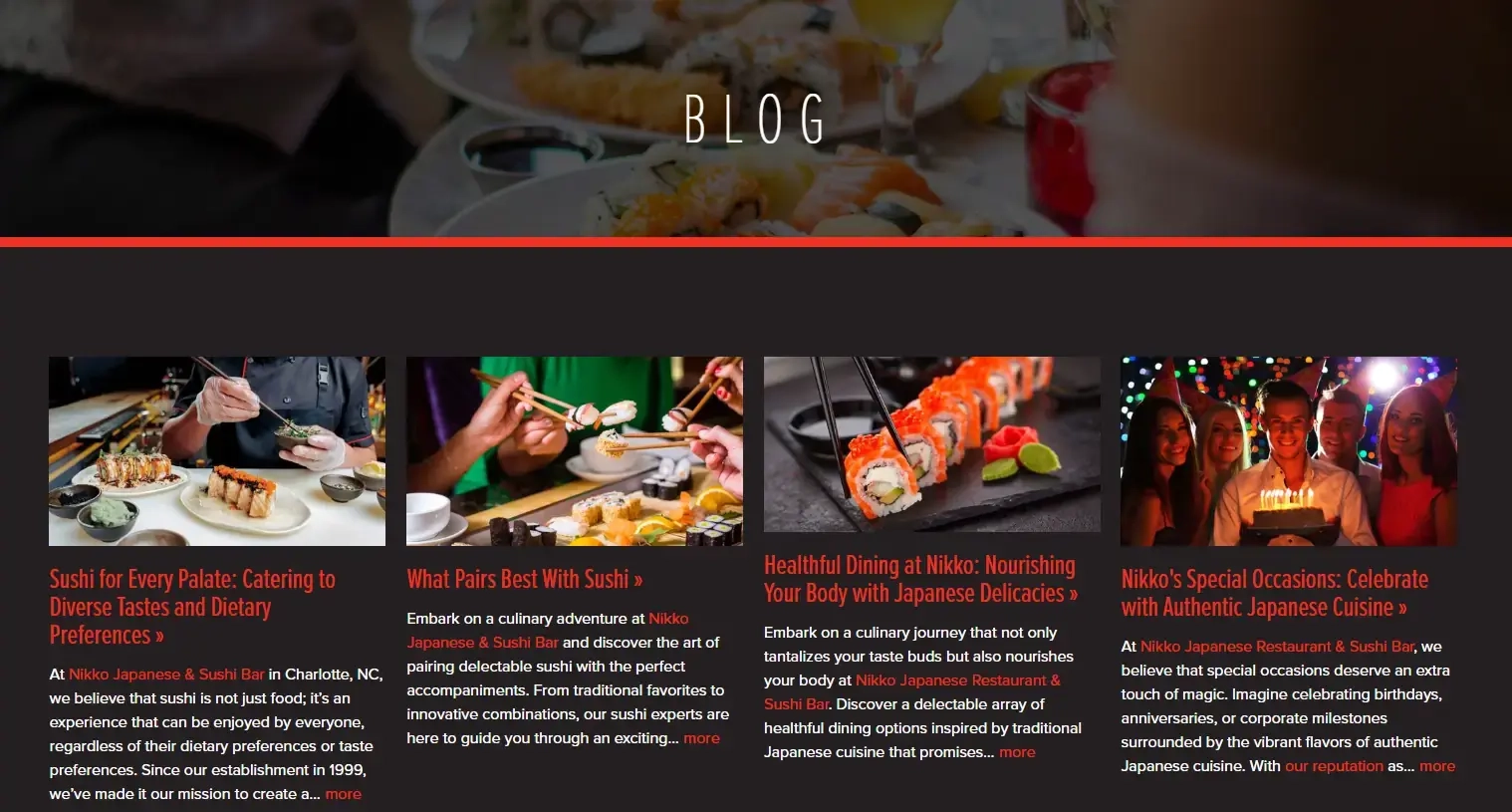
The Only Solution You Need for High-Quality Backlinks
Good SEO can help you show up higher (and better) in search results, help local customers find you, and get more foot traffic.
While great food brings people to your restaurant, solid backlinks bring people to your website.
If you want your restaurant to stand out in search results, climb the rankings, and stay ahead of your competitors, link building isn’t optional; it’s essential.
But not just any links will do. You need high-quality backlinks from trusted, relevant sources that actually make a difference.
At LinkBuilder, we know how to build links that Google (and your guests) trust and use smart strategies that help your restaurant rise to the top.
Contact us today and let’s get more eyes on your menu and more diners through the door.

